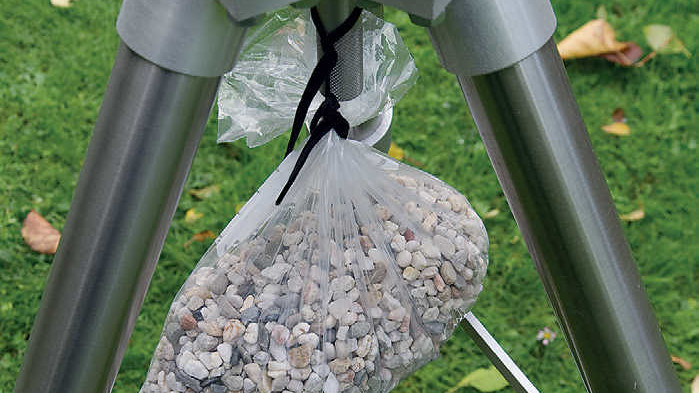Stable position
A vibration-free tripod is your telescope’s foundation. Vibrations can be reduced with an improvised pendulum.
 You can easily improvise a pendulum which will dampen vibration. S. Wienstein
You can easily improvise a pendulum which will dampen vibration. S. WiensteinNo matter what sits on top, the tripod is at the bottom of the chain and has the greatest load to carry. This means that even the smallest improvements in this area can have a big effect. Important here is vibration behaviour – because the main symptom of an overloaded tripod and mount is unpleasant vibration – long before anything actually physically breaks.
First of all, you should make things as easy as possible for your tripod. The legs should only be extended as far as is necessary for comfortable observation. The further they are extended, the less overlap there is between the sections, and the more length there is that can potentially vibrate. The tripod spreader also has its purpose and does more than just hold the storage shelf.
If you have too much load, you may find that you only need to replace the tripod with a sturdier model, while the mount itself has not yet reached its limit. Long tripod legs can be avoided by using a centre column attachment on the tripod head. This changes the vibration behaviour, but does not necessarily guarantee an improvement.
Vibration damping using a pendulum
You can try suspending a pendulum under the tripod head to dampen vibrations. Vibration dampers in high-rise buildings work on the same principle. The shorter the pendulum, the higher the frequencies it best absorbs. If you’re on the move, a bag filled with sand or a water bottle can do an equally good job. The weight and cord length should be varied. Adding weight to the storage shelf is also worth a try. To test the result, add something everyday like a small focus corrector to the eyepiece. Then see how long the image shakes in the eyepiece afterwards. But bear in mind that a pendulum cannot work miracles.
Author: Sven Wienstein / Licence: Oculum Verlag GmbH
